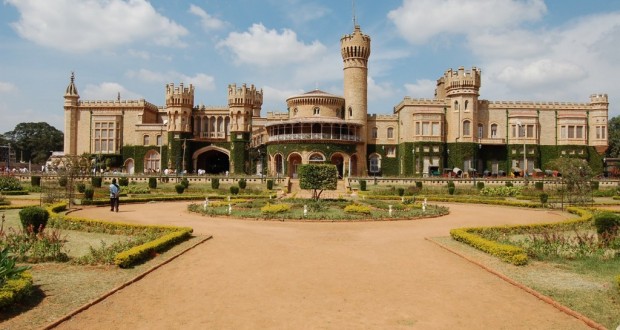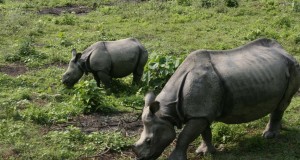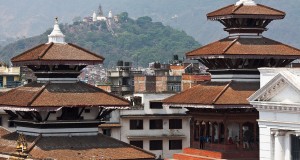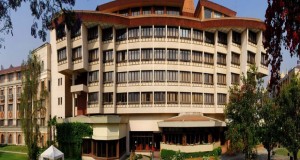Because Bangalore has few sights of its own, and these widely dispersed, travellers tend to spend just a couple of days here, resting up and cooling off before heading to Bombay, Goa or further south. But if there’s little to see in the city, there are some marvellous spots just outside it. A number of good tours run out to Hampi and Ooty, to Belur /Halebid, to Eandipur Tiger Reserve and Nagarhole National Park, and (best of all) to Mysore, Sriringapatna and Brindhavan Gardens.
For orientation in Bangalore itself, use taxis or auto-rickshaws. The latter 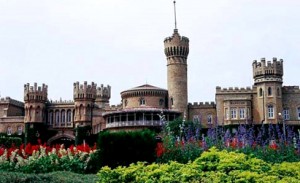 are Rs2.50 per km, and generally use the meter. Trying to get around on foot is a disheartening experience: this is a big city, with very long roads (few of them well-signed), and all interest spots miles away from each other. The ‘budget’ sector, with the cheaper hotels and restaurants, is around the bus and rail stations on the east of town, and is perhaps the easiest area in which to acclimatise to the busy city. The best time for independent sightseeing is the afternoon, when Bangalore goes into siesta. For a quick, comprehensive overview of the city take a conducted tour. Follow this with a day of shopping (excellent here) or discover the beautiful parks. Out-of-town excursions are optional extras.
are Rs2.50 per km, and generally use the meter. Trying to get around on foot is a disheartening experience: this is a big city, with very long roads (few of them well-signed), and all interest spots miles away from each other. The ‘budget’ sector, with the cheaper hotels and restaurants, is around the bus and rail stations on the east of town, and is perhaps the easiest area in which to acclimatise to the busy city. The best time for independent sightseeing is the afternoon, when Bangalore goes into siesta. For a quick, comprehensive overview of the city take a conducted tour. Follow this with a day of shopping (excellent here) or discover the beautiful parks. Out-of-town excursions are optional extras.
City Tour (by sightseeing bus, morning or afternoon)
Government Museum/Art Gallery-Tipu Sultan’s Palace-Bull Temple-Lal Bagh-Ulsoor Lake
A short tour of the palatial buildings round Cubbon Park brings you to the three museums in Jayachamarajendra Park. Best of these is Government Museum, one of the oldest museums in India (established 1866). It has 18 sections, housing fine collections of miniatures, inscriptions, coins and sculptures recovered from the neolithic-period Chandraval excavation. The Venkatappa  Art Gallery forms one wing of this museum, and has well-presented exhibitions of water-colours, plasterof- Paris sculptures, bronze antiquities and various contemporary works of art (by famous artist Venkatappa and other court painters). There are regular modern-art exhibitions on the third floor. Open 10 am-5 pm daily (except Wednesday), admission Rsl. The adjoining Technological Museum is generally unexciting. Just down the road, opposite Queen Victoria’s statue, is the Aquarium. It’s not covered by the tour, but is worth returning to (open 10 am-7.30 pm daily, except Monday, admission Rsl).
Art Gallery forms one wing of this museum, and has well-presented exhibitions of water-colours, plasterof- Paris sculptures, bronze antiquities and various contemporary works of art (by famous artist Venkatappa and other court painters). There are regular modern-art exhibitions on the third floor. Open 10 am-5 pm daily (except Wednesday), admission Rsl. The adjoining Technological Museum is generally unexciting. Just down the road, opposite Queen Victoria’s statue, is the Aquarium. It’s not covered by the tour, but is worth returning to (open 10 am-7.30 pm daily, except Monday, admission Rsl).
South of town (1 km; 1/2 mile from City Market), you’ll visit Tempe Gowda Fort, Hyder Ali’s stone construction (built 1761) on the site of the original mud fort. While the fort interior is closed to the public you can enter the first two courtyards and pass through an impressive gateway. The exterior view of the lovely 16th-century Ganpati Temple within the walls merely whets the appetite. Much more satisfying is Tipu Sultan’s Palace, started by Hyder Ali in 1781, completed by Tipu in 1789. One of three summer palaces built by the two Mysore rulers, it is (like the others) made entirely of wood, except for the internal pillar-supports. Within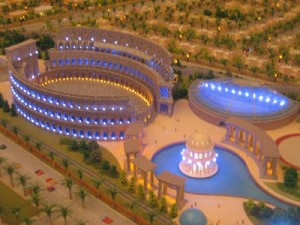 are gloriously painted walls, ceilings, balconies and soaring pillars of green, red, black and gold; also elaborate arches, surrounded by minarets and family paintings. As at Maria Daulat, the palace here has a small museum, illustrating the life and times of Tipu Sultan, who presented the British with their most stubborn resistance in the south. Open 8 am-6 pm daily.
are gloriously painted walls, ceilings, balconies and soaring pillars of green, red, black and gold; also elaborate arches, surrounded by minarets and family paintings. As at Maria Daulat, the palace here has a small museum, illustrating the life and times of Tipu Sultan, who presented the British with their most stubborn resistance in the south. Open 8 am-6 pm daily.
Near the palace you’ll see the Venkataramanaswamy Temple, built by the Wodeyars in the 17th century. An attractive example of Dravidian-style architecture, it was restored for the use of the Wodeyar kings who recovered their throne after Tipu’s death in 1799.
From the palace, it’s a 1.5-km (1-mile) drive south to the Bull Temple up on Bugle Hill. Here you’ll find the fourth-largest Nandi bull in India, made of black granite and measuring 6.3 m across by 4.6 m high. Credited with miraculous ‘growing’ power, the Nandi is chiefly notable for being so much larger than its ‘master’, Shiva. You’ll find Shiva’s tiny image in the small temple at the foot of the hill. Also here is the strange Ganesh Temple, with its large elephant made of 110 kilos of butter. Donated by wealthy devotees, the butter is broken up every four years and distributed to pilgrims. Local philanthropists are then ‘buttered up’ to donate a fresh coating.
The beautiful botanical gardens of Lal Bagh, 2 km (11/4 miles) south-east of the City Market, were laid out by Hyder Ali in 1760, and substantially added to by Tipu Sultan. Smaller than Cubbon Park, they are in every way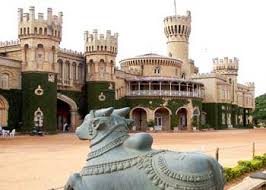 superior-97 hectares (240 acres) of trees and plants (1000 tropical and sub-tropical varieties, many of them rare), 19th-century pavilions and lamps, landscaped gardens and avenues, fountains and flower-beds, even an elegant glasshouse modelled on London’s Crystal Palace! The best time to see the dahlias, marigolds, rose gardens and many flowers here is either January or August. Just up from the entrance, overlooked by Kempe Gowda’s statue, is the flower-bordered Lawn Clock (completed 1983), accurate to three seconds each month. Just right of this is the area where visiting dignitaries/state leaders are invited to ‘dedicate a tree’ (in olden days, they had expensive monuments erected to them, now they get a shrub).
superior-97 hectares (240 acres) of trees and plants (1000 tropical and sub-tropical varieties, many of them rare), 19th-century pavilions and lamps, landscaped gardens and avenues, fountains and flower-beds, even an elegant glasshouse modelled on London’s Crystal Palace! The best time to see the dahlias, marigolds, rose gardens and many flowers here is either January or August. Just up from the entrance, overlooked by Kempe Gowda’s statue, is the flower-bordered Lawn Clock (completed 1983), accurate to three seconds each month. Just right of this is the area where visiting dignitaries/state leaders are invited to ‘dedicate a tree’ (in olden days, they had expensive monuments erected to them, now they get a shrub).
Ulsoor Lake, last stop of the day, is on the eastern edge of town (3 km; 2 miles from the bus-station). A pleasant boating lake with eagles, islands and rose-pink water lilies, it has a small Boat Club (rowing boats for hire at Rs15 per hour) and a peaceful ‘Kensington Gardens’. Open 9.30 am-5.30 pm daily.
Around sunset, take an enjoyable 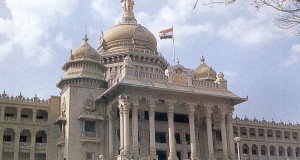 promenade down Vidhana Vidhi (Bangalore’s finest avenue) and admire its attractive selection of Greco-colonial style buildings. Start with the palatial post office (India’s grandest) and walk down the tree-lined boulevard to Attara Kacheri (’18 Courts’), the stately red-brick structure housing the High Court. Recently saved from development and now restored to its original splendour. Opposite this is the magnificent post-Independence Vidhana Souda, housing the Secretariat and the Legislature. Built in 1954, this is a four-storey ornamental structure of solid granite, designed in the neo-Dravidian style. It is notable for its soaring columns, charming frescoes and excellent carvings. Visitors are only allowed inside between 3.30 and 5.30 pm, and must get permission from the public relations officer in the entrance lobby. If you’re around on a Sunday evening (between 7 and 9 pm), you can see Vidhana Souda beautifully illuminated. Just down the road, at the bottom of Vidhana Vidhi, Cubbon Park has nightly illuminations and features a popular ‘Fairy Fountain’.
promenade down Vidhana Vidhi (Bangalore’s finest avenue) and admire its attractive selection of Greco-colonial style buildings. Start with the palatial post office (India’s grandest) and walk down the tree-lined boulevard to Attara Kacheri (’18 Courts’), the stately red-brick structure housing the High Court. Recently saved from development and now restored to its original splendour. Opposite this is the magnificent post-Independence Vidhana Souda, housing the Secretariat and the Legislature. Built in 1954, this is a four-storey ornamental structure of solid granite, designed in the neo-Dravidian style. It is notable for its soaring columns, charming frescoes and excellent carvings. Visitors are only allowed inside between 3.30 and 5.30 pm, and must get permission from the public relations officer in the entrance lobby. If you’re around on a Sunday evening (between 7 and 9 pm), you can see Vidhana Souda beautifully illuminated. Just down the road, at the bottom of Vidhana Vidhi, Cubbon Park has nightly illuminations and features a popular ‘Fairy Fountain’.
RECREATION
Bangalore is one of the few Indian cities with any real claim to nightlife. There’s a wide selection of bars and restaurants, clubs and discotheques, and your hotel will always have some recommendations. Otherwise try one of the 100 or so cinemas here; Bangalore is a film-making capital. A few theatres along M.G. and Brigade Roads show recent English-speaking releases.
Cultural entertainments are best in March–April, when regular shows of Karnataka dance and music are held at Chowdiah Memorial Hall, Sankey Rd and Bharatiya Vidya Bhavan. For details of current programmes and events (there’s something going on most evenings), buy a Deacon Herald or Indian Express newspaper. The cultural shows held at State Youth Centre, Nrupathunga Rd, are supposed to be especially good.
For outdoor recreation, there’s horse-racing at Bangalore’s beautiful racecourse (November–March, mid-April to July), fishing at Hesaraghatta Lake or Chamarjasagar Reservoir (enquire at the tourist office), and good golfing at the 18-hole course in the city centre (nearby Windsor Manor or West End hotels arrange games for visitors).
SHOPPING
Next to Madras, Bangalore is the prime shopping centre of the south. It is famous for its fine silk, particularly traditional Mysore silk saris. Other good buys include rosewood, sandalwood, lacquerware, bidriw are and wooden-inlay items. Many people go for (cheaper) imitation silks, attractive bangles, handloom fabrics and jewellery. A good place to see the range is the Cottage Industries Emporium on Mahatma Gandhi (M.G.) Rd, alternatively the Cauvery Arts & Crafts Emporium, 26 M.G. Rd. The latter is particularly good for hand-crafted rosewood furniture and sandalwood carvings.
For quality silks, try Janardhana Silk House, located in the main general shopping complex of Unity Buildings, Jaya Chamaraja Rd. For cheaper silks and textiles and I amazing atmosphere, there’s the City Market in Chickpet, or the big shopping centre in M.G. Rd. For gold and silver jewellery, the best shops are in Commercial St.

